Sonus Paradisi
Frankfurt a.d. Oder, 1975 [Hauptwerk]
Frankfurt a.d. Oder, 1975 [Hauptwerk]
No se pudo cargar la disponibilidad de retiro
Frankfurt an der Oder, Sauer organ, op. 2025 (1975)
Presented to you by Leonart Studio, your authorised reseller for Sonus Paradisi in Switzerland (shipped internationally). Get your digitally sampled historical organs for the use with the Hauptwerk virtual instrument software.
Share this Sample Set
![Frankfurt a.d. Oder, 1975 [Hauptwerk]](http://artful.shop/cdn/shop/files/ss_frankfurtoder1.jpg?v=1692974219&width=1445)
![Frankfurt a.d. Oder, 1975 [Hauptwerk]](http://artful.shop/cdn/shop/files/ss_frankfurtoder2.jpg?v=1692974220&width=1445)
![Frankfurt a.d. Oder, 1975 [Hauptwerk]](http://artful.shop/cdn/shop/files/ss_frankfurtoder3.jpg?v=1692974221&width=1445)
![Frankfurt a.d. Oder, 1975 [Hauptwerk]](http://artful.shop/cdn/shop/files/ss_frankfurtoder4.jpg?v=1692974221&width=1445)
![Frankfurt a.d. Oder, 1975 [Hauptwerk]](http://artful.shop/cdn/shop/files/ss_frankfurtoder5.jpg?v=1692974220&width=1445)
![Frankfurt a.d. Oder, 1975 [Hauptwerk]](http://artful.shop/cdn/shop/files/ss_frankfurtoder11_485d7d2a-93a0-406e-a425-962e8124ad71.jpg?v=1692974221&width=1445)
Specification (stop list)
-
Manual I
Rückpositiv C–c4
Holzgedackt 8'
Quintadena 8'
Praestant 4'
Rohrflöte 4'
Oktave 2'
Terz 1 3/5'
Quinte 1 1/3'
Gemshorn 1'
Scharff IV
Holzregal 8'
Tremulant -
Manual II
Hauptwerk C–c4
Pommer 16'
Prinzipal 8'
Gemshorn 8'
Oktave 4'
Kleingedackt 4'
Nasat 2 2/3'
Oktave 2'
Blockflöte 2'
Mixtur V-VI
Zimbel III
Fagott 16'
Trompete 8'
Tremulant -
Manual III
Swell C–c4 (enclosed)
Bordun 16'
Holzprinzipal 8'
Rohrgedackt 8'
Salizional 8'
Oktave 4'
Spitzflöte 4'
Waldflöte 2'
Septime 1 1/7'
Oktävlein 1'
Sesquialtera II
Quintan 1 1/3'+8/9'
Mixtur V-VII
Dulzian 16'
Oboe 8'
Helltrompete 4'
Kornettzug
Schwebung* 8'
Tremulant -
Manual IV
-
-
Pedal
Pedal C-f1 [-g1]
Untersatz** 32'
Subbass* 32'
Prinzipal 16'
Subbass 16'
Oktavbass 8'
Pommer 8'
Hohlflöte 4'
Rohrpfeife 2'
Gr. Sesquialtera III
Mixtur VII
Sordun 32'
Posaune 16'
Bombarde 8'
Corno 4'
Singend Kornett 2'
Kornettzug -
Other specification
* - stop added virtually by Sonus Paradisi.
** - not a real stop, but an internal coupler drawing the low quint of the engaged pedal stop, to emulate a resultant 32'.
All the usual couplers available, including most of the sub- or super- couplers.
Accessories:
Tutti
Crescendo
Swell pedal
"Schweller an" switch. It is a servo aid for an easier move of the swell pedal on the real organ, a switch of no use for the sample set. However, there is a function for the switch in the sample set. The switch is used to enhance the swell functionality in a special way. It has been used to enclose the SW Oktave 4' stop. This stop is in the facade on the real organ, unenclosed. Therefore, the swell does not react on the Oktave 4' in the sample set by default. However, the Schweller an switch will make the swell operating on the SW Oktave 4', too.
History
Frankfurt a/Oder, Sauer organ, op. 2025 (1975)
The Carl Philipp Emmanuel Bach Concert Hall in Frankfurt (Oder) was originally a Franciscan monastery. The organ in the hall was built by Sauer in 1975 as Opus 2025. The Sauer company is world famous for top-quality Romantic instruments (such as the Chemnitz organ modeled by Sonus Paradisi). But few people know that the organ building at the company continued throughout the 20th century, and even today the company builds and services pipe organs. In the second half of the 20th century, the company built neo-baroque instruments. as was the current fashion. The Opus 2025 is an excellent representative of this movement. Unlike many instruments of the period, which often have lackluster voicing and a sound that borders on boring, this instrument stands out with its meticulous voicing, especially in the labial stops. For this reason, we have decided to include it in the Sonus Paradisi portfolio.
The organ's layout is typical of its time, based strictly on the "Werkprinzip" hierarchy. Not to be overlooked are the strange aliquots, including septimes and nones, the high-pitched mixtures, and the characteristic dominant flute sound of the foundation stops. The reed registers are rather narrow in sound, always needing to be paired (covered) by a labial stop. Also very successful is the Holzprincipal in the swell, which is essentially a "secret" Flute Harmonique. Thanks to the Sauer tradition of voicing and the craftmanship of this organ, it transcends the narrow confines of the neo-baroque sound ideal.
The organ was overhauled in 2019/20, and a new mobile console has been added to allow the organ to be easily used together with the orchestra. Fortunately, the voicing of the organ was not altered during this restoration, so we can still hear the mastery of Sauer's voicers today.
For the sample set we decided to stick to the layout of the original old console, and from the new console only the newly added couplers were incorporated. Also, we decided to add a single register, namely the Schwebung on the III manual, which can be used together with the Salicional to obtain the typical undulating effect. Although not normally found on the mid-1970s organs in this style, just a few years later Sauer began to build undulating registers into their new organs. This greatly expanded the organ's usefulness for a variety of repertoire.
Features
Encryption
The samples are offered in 48kHz/24bit resolution. The multiple releases have three levels: short, mid and long. Hauptwerk v4.2 and higher supported. The sample set is offered in a plain wave format, no encryption.
Reverb time
The reverb time is ca. 3 seconds.
Keyboards, pedalboard
The original compass of the keyboards is 61 keys (full 5 octaves). The original compass of the pedal division is 30 keys. The pedal was extended virtually to 32 keys (activation of the pedal extension is achieved through the mixer tab).
Tremulants
All ranks were recorded with and without tremulants for the most convincing tremulant behavior. However, loading the authentic tremmed ranks consumes large amount of RAM. It is possible to select to use the artificial tremulant instead to save RAM (the switch is located on the mixer tab).
Surround format
The sample set is offered in a Surround variant (6 channels). There are two direct channels, two diffuse channels and two rear channels.
The semi-dry channels were recorded at short distance from the organ.
To reproduce the surround format, an audio card with at least 4 output channels is required, dedicating the direct and diffuse channels for the front speakers, and other two channels for the rear speakers.
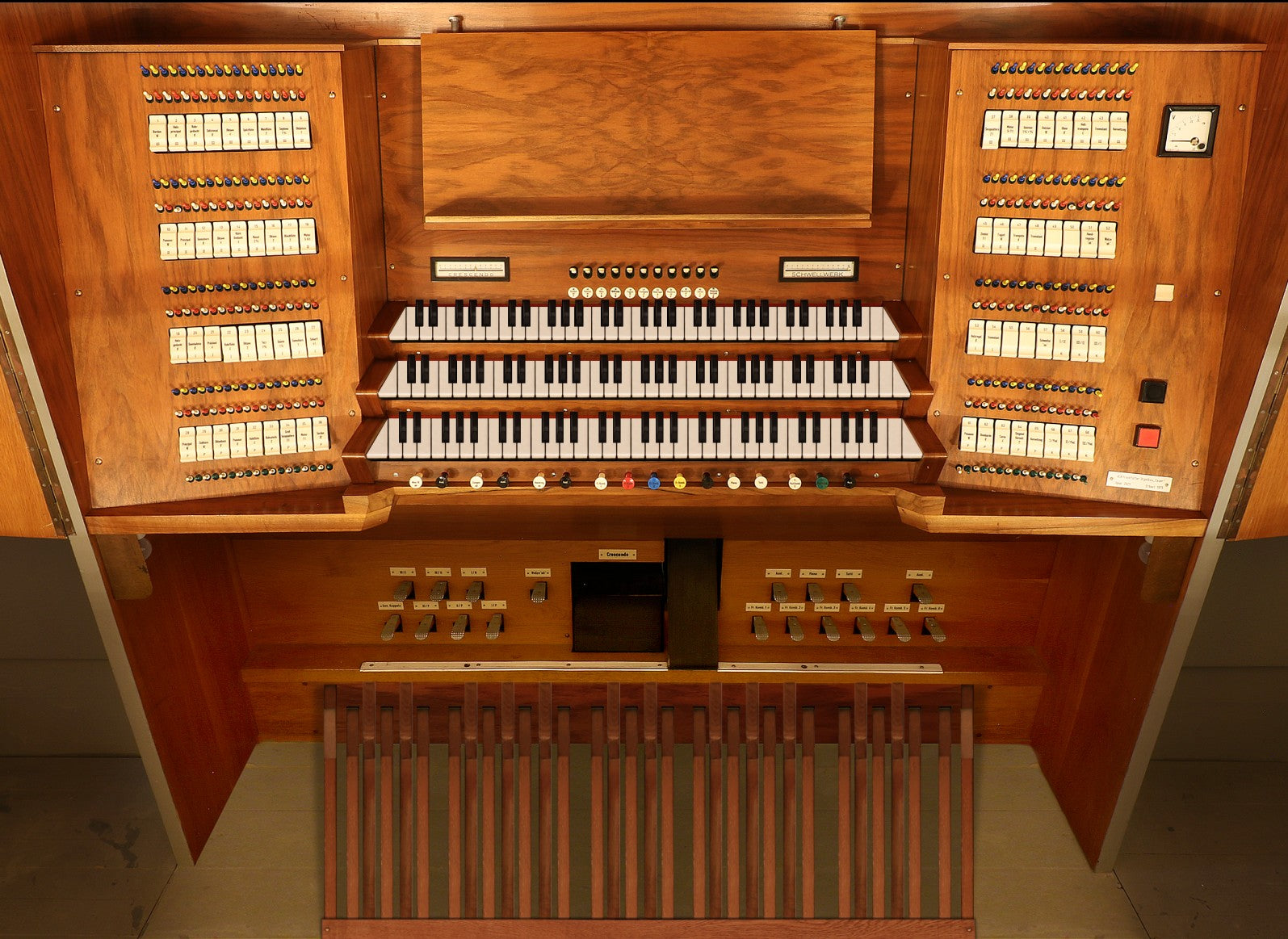
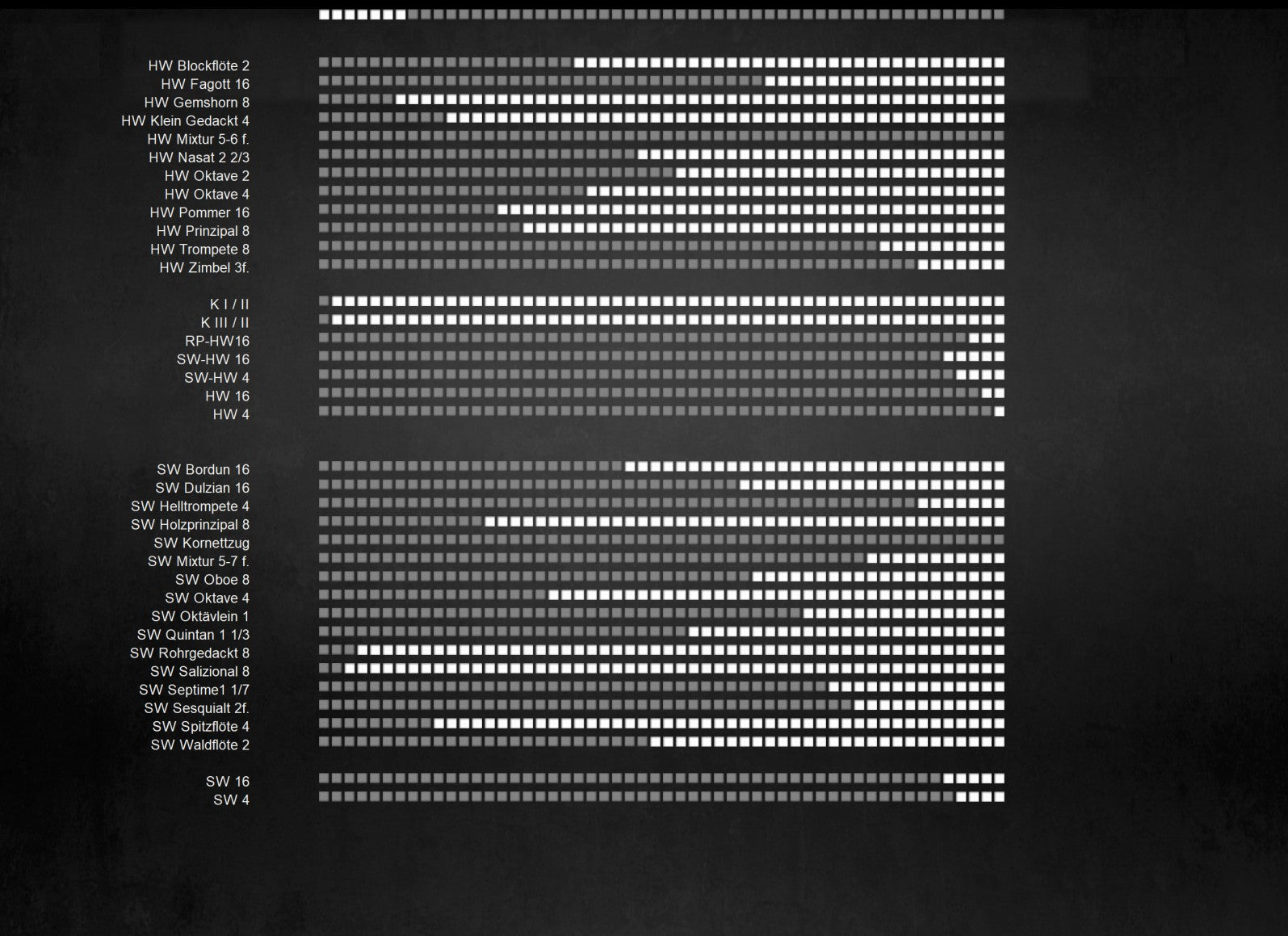
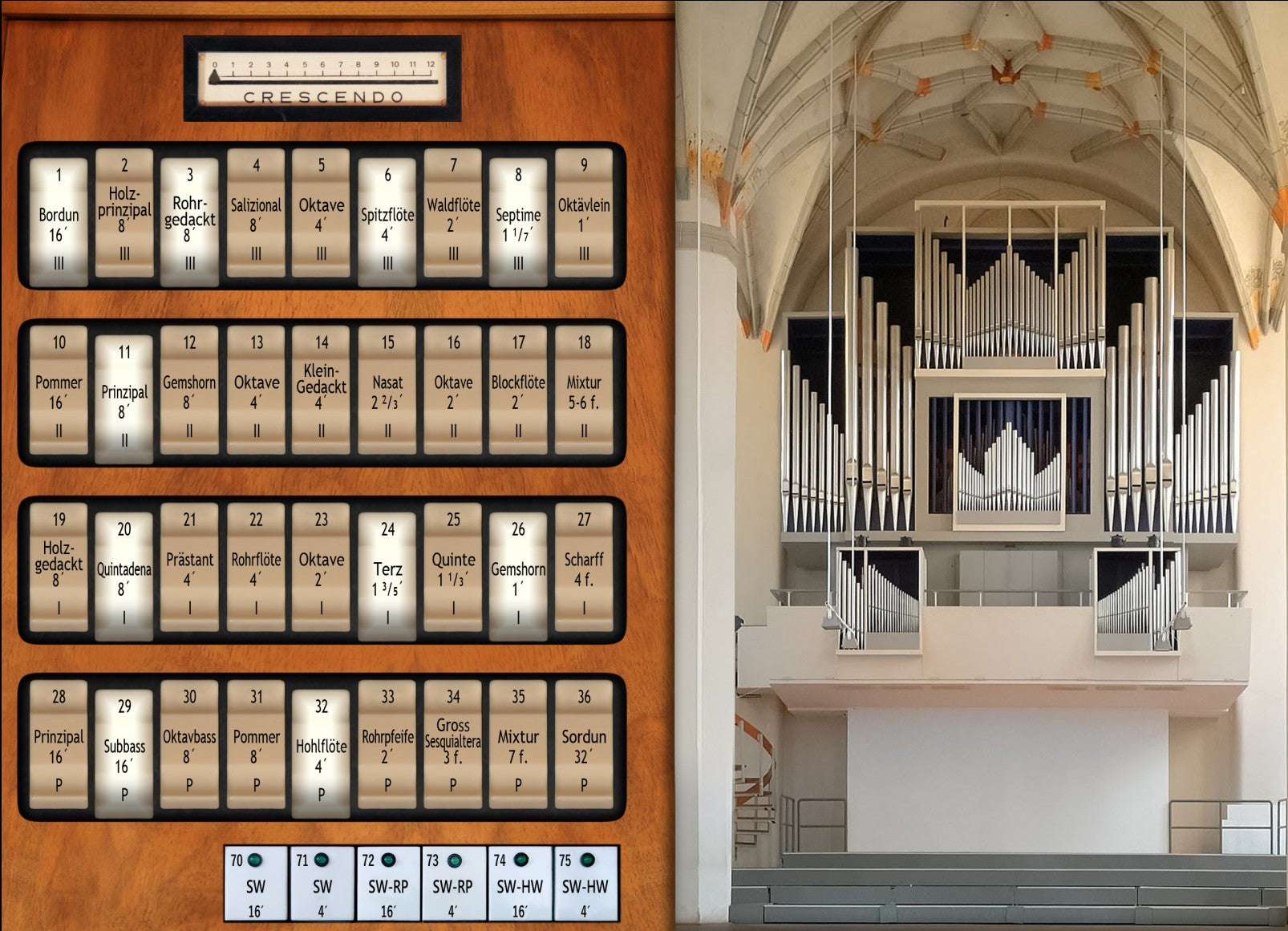
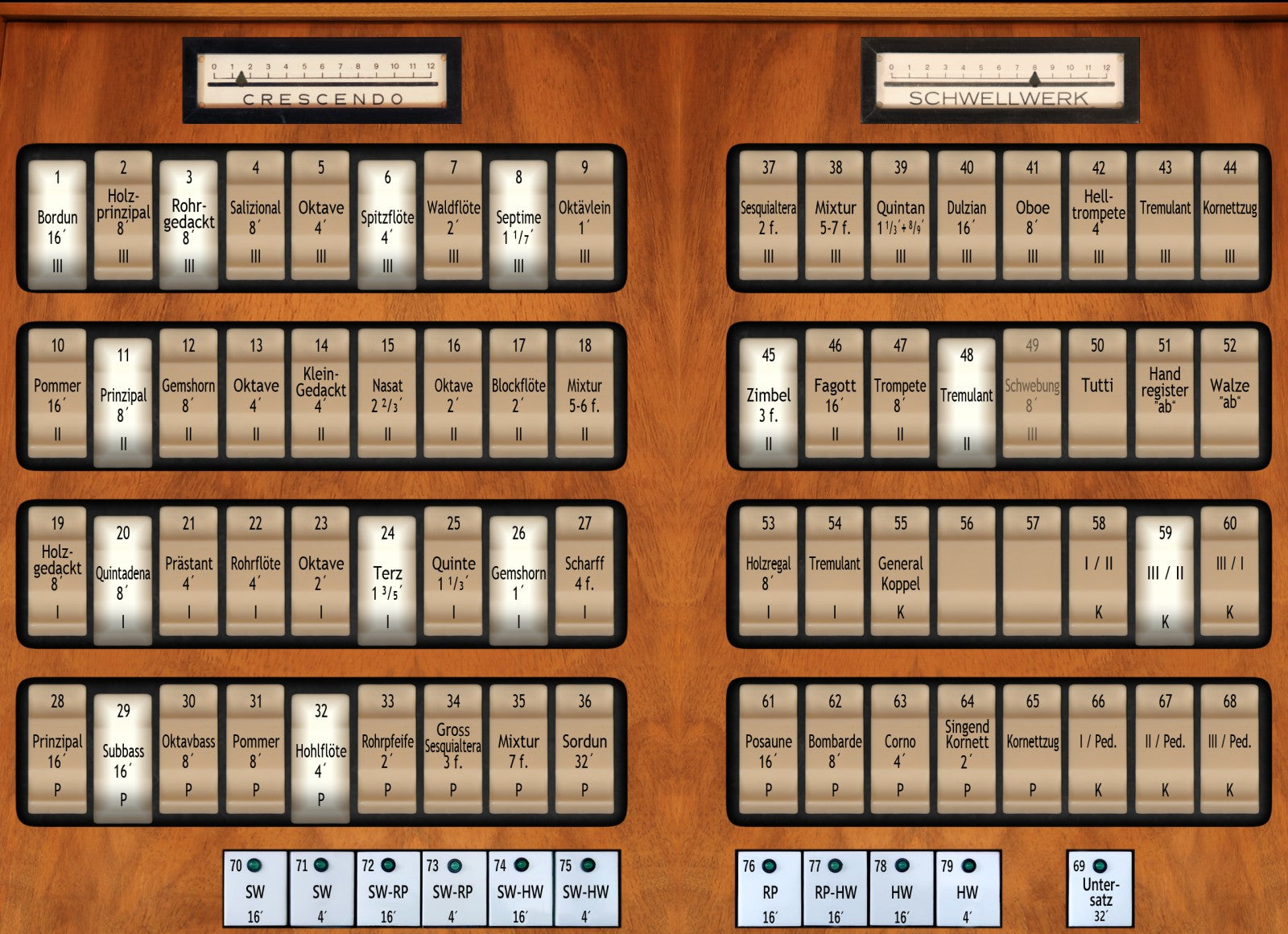
Requirements
Hauptwerk v4.2 and higher supported. The sample set is offered in a plain wave format, no encryption.
RAM consumption: 6-channel surround
16-bit, other settings default: 28 GB
20-bit, other settings default: 45 GB
24-bit, other settings default: 53 GB
* loading in 16-bit depth is NOT recommended due to high amount of digital hiss emerging, since the noise floor of the 16-bit depth is too high and very audible with the many samples sounding simultaneously.
RAM consumption: the semi-dry channel solo
20-bit, other settings default: 16 GB
Screen resolution 1280x1024 px or more.
Polyphony of 10.000 voices recommended for the full suround.
This Hauptwerk Sample Set is presented to you by Leonart Studio, an authorised reseller for the manufacturer Sonus Paradisi in Switzerland (shipping internationally). Enjoy this digitally sampled organ library for the use with Hauptwerk software and start expanding your historical organ collection today.
0
Total de artículos
CHF 0.00
Subtotal de productos
More Hauptwerk Sample Sets
-
Casavant, 1995 [Hauptwerk]
Proveedor:Sonus ParadisiPrecio habitual CHF 174.90Precio habitualPrecio unitario / por -
Reuter, 1928 [Hauptwerk]
Proveedor:Sonus ParadisiPrecio habitual CHF 473.00Precio habitualPrecio unitario / por -
Rotterdam Hoofdorgel, 1973 [Hauptwerk]
Proveedor:Sonus ParadisiPrecio habitual A partir de CHF 330.00Precio habitualPrecio unitario / porCHF 958.10Precio de oferta A partir de CHF 330.00Oferta -
Groningen, 1450-1740 [Hauptwerk]
Proveedor:Sonus ParadisiPrecio habitual A partir de CHF 658.90Precio habitualPrecio unitario / porCHF 1,681.90Precio de oferta A partir de CHF 658.90Oferta -
Goerlitz, 2006 [Hauptwerk]
Proveedor:Sonus ParadisiPrecio habitual A partir de CHF 328.90Precio habitualPrecio unitario / por -
Bückeburg, 1997 [Hauptwerk]
Proveedor:Sonus ParadisiPrecio habitual A partir de CHF 1.10Precio habitualPrecio unitario / por -
Brasov, 1839 [Hauptwerk]
Proveedor:Sonus ParadisiPrecio habitual CHF 418.00Precio habitualPrecio unitario / por -
St. Omer, 1717-1855 [Hauptwerk]
Proveedor:Sonus ParadisiPrecio habitual CHF 323.40Precio habitualPrecio unitario / porCHF 410.96Precio de oferta CHF 323.40Oferta -
Stellwagen organ, St. Marien, Stralsund (1659)
Proveedor:Sonus ParadisiPrecio habitual CHF 858.00Precio habitualPrecio unitario / por -
![Clavichord Model [Hauptwerk]](//artful.shop/cdn/shop/files/ss_clavichord.jpg?v=1724310155&width=533) Agotado
AgotadoClavichord Model [Hauptwerk]
Proveedor:Sonus ParadisiPrecio habitual CHF 33.00Precio habitualPrecio unitario / por

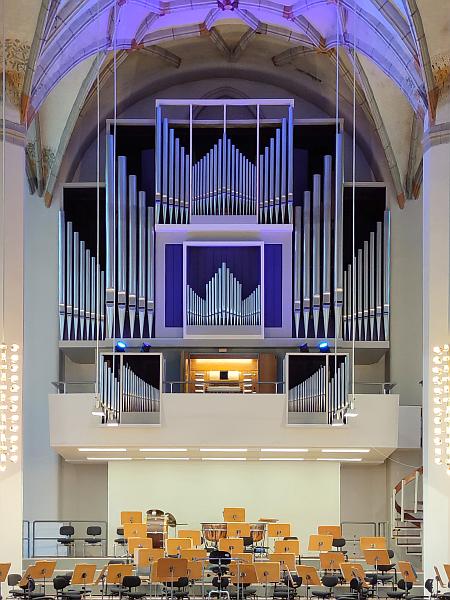



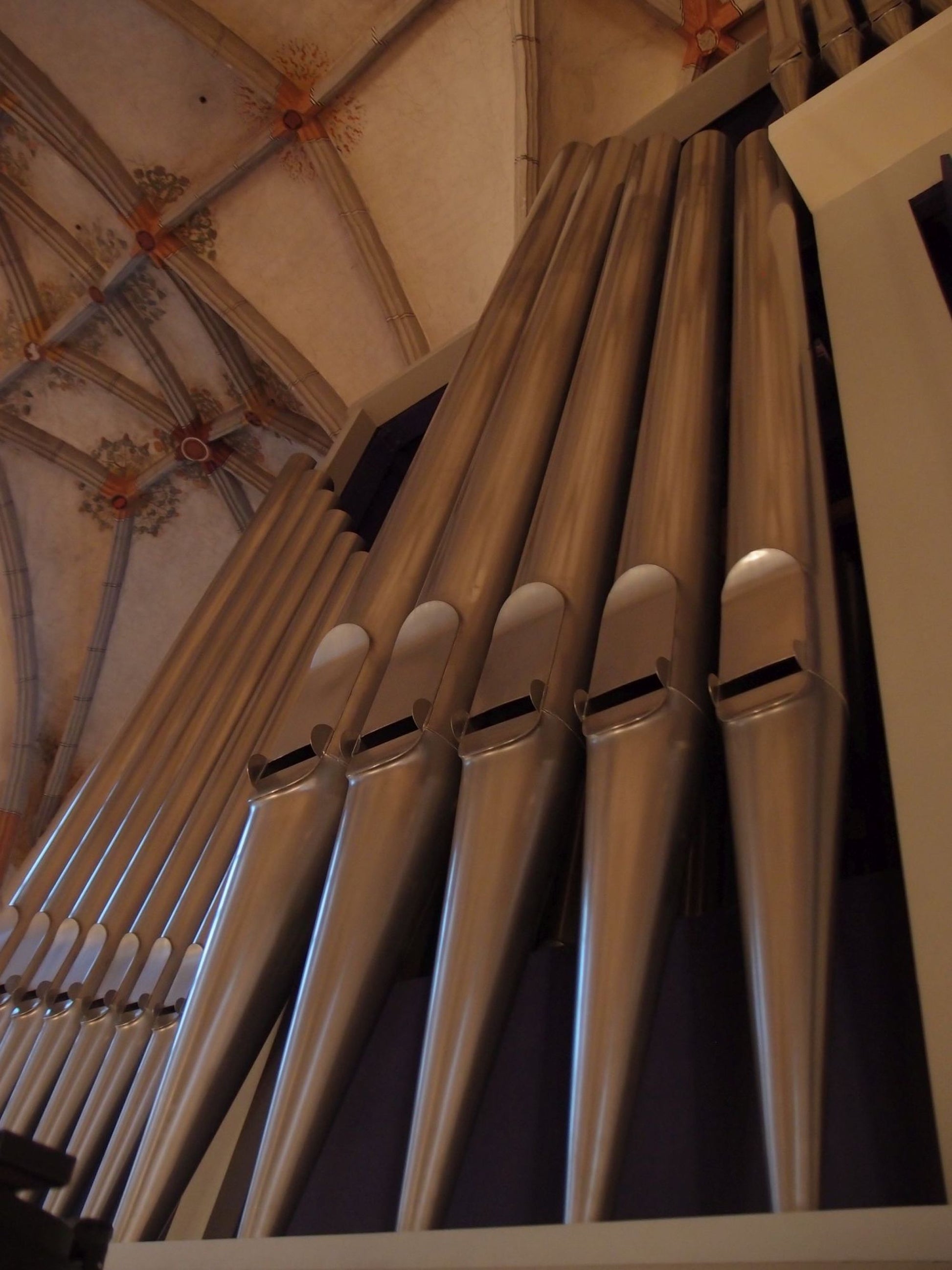
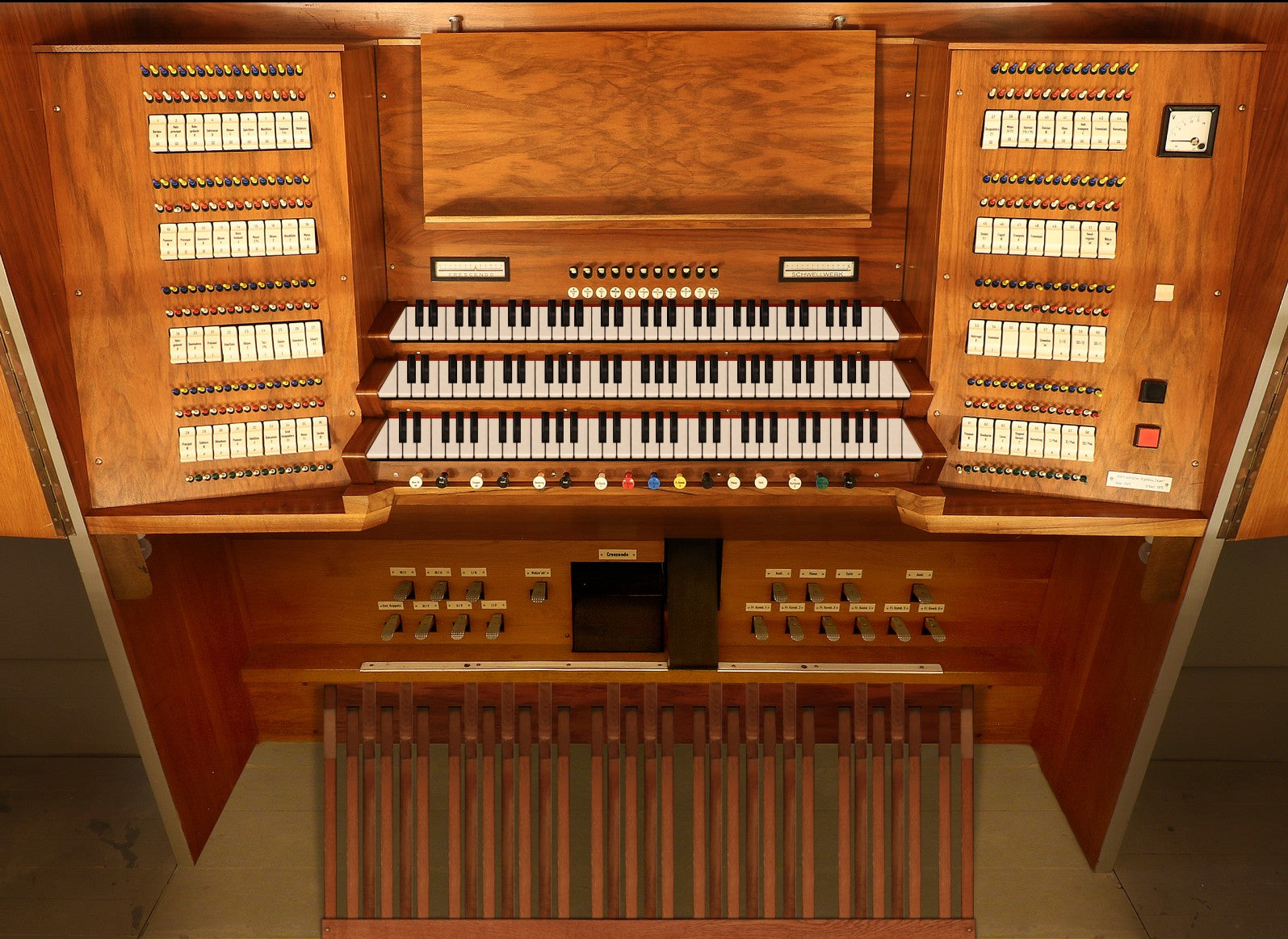
![Casavant, 1995 [Hauptwerk]](http://artful.shop/cdn/shop/files/ss_casavant1.jpg?v=1693319885&width=533)
![Reuter, 1928 [Hauptwerk]](http://artful.shop/cdn/shop/files/ss_Reuter1.jpg?v=1693321024&width=533)
![Rotterdam Hoofdorgel, 1973 [Hauptwerk]](http://artful.shop/cdn/shop/files/ss_RotterdamMain1.jpg?v=1693279529&width=533)
![Groningen, 1450-1740 [Hauptwerk]](http://artful.shop/cdn/shop/files/ss_Groningen1.jpg?v=1693275425&width=533)
![Goerlitz, 2006 [Hauptwerk]](http://artful.shop/cdn/shop/files/ss_goerlitz1.jpg?v=1692995837&width=533)
![Bückeburg, 1997 [Hauptwerk]](http://artful.shop/cdn/shop/files/ss_bueckeburg1.jpg?v=1692967628&width=533)
![Brasov, 1839 [Hauptwerk]](http://artful.shop/cdn/shop/files/ss_brasov1.jpg?v=1692967057&width=533)
![St. Omer, 1717-1855 [Hauptwerk]](http://artful.shop/cdn/shop/files/ss_omer1.jpg?v=1692904128&width=533)
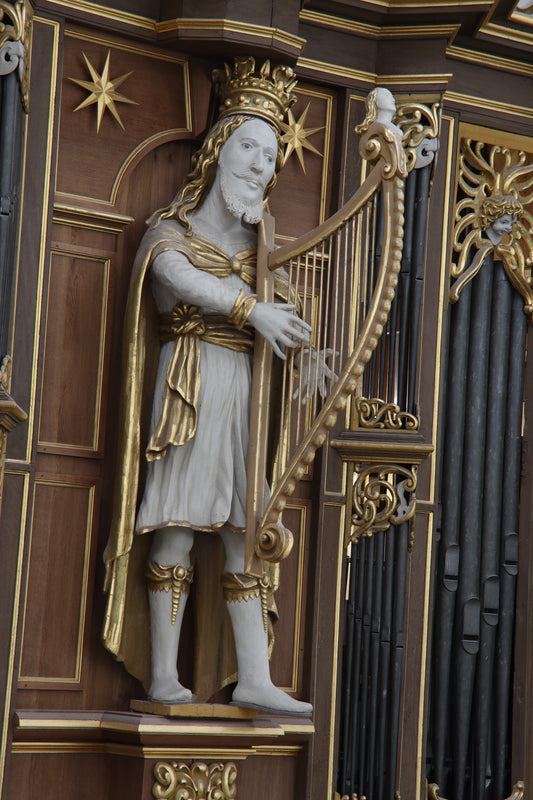
![Clavichord Model [Hauptwerk]](http://artful.shop/cdn/shop/files/ss_clavichord.jpg?v=1724310155&width=533)